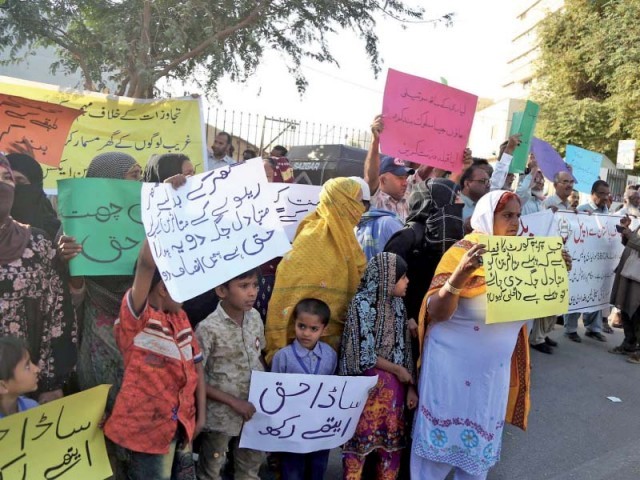
KARACHI: As the Supreme Court resumed hearings at its Karachi Registry on Friday, protesters affected by the anti-encroachment operations in the city crowded the road in front of the building, demanding justice.
Most of the protesters were residents from Lines Area and Gulshan-e-Maymar, while the throng also included retired employees of the Pakistan Steel Mills who wanted plots that had been promised to them. Awaiting the arrival of the Chief Justice of Pakistan (CJP), they held up placards and banners.
Inside the court, the bench vacated a stay order against the demolition drive that had previously been issued by the Sindh High Court.
Several of the demonstrators, who included women and children, were raising their voices to demand alternative housing before their residences were razed from land allotted for the restoration of the Karachi Circular Railway (KCR), in line with judicial orders.
“Ghar ke badlay ghar [a house for a house],” stated one placard, adding that it was their right to be provided alternative housing. Another said, “Saada haq aithay rakh [give us our rights]” while yet another asked how they could be deprived of housing when the Supreme Court had ordered that they be resettled first.
Meanwhile, former Muttahida Qaumi Movement-Pakistan leader Farooq Sattar, Pakistan Tehreek-e-Insaf (PTI) leaders Firdous Shamim Naqvi and Raja Azhar, Sindh Education Minister Saeed Ghani and Pakistan Peoples Party (PPP) politician Najmi Alam expressed solidarity with the protesters.
“No one is willing to take responsibility. No political party is willing to own Karachi,” asserted Sattar, pointing out that people were being left homeless with their houses razed. “The federal government shifts the burden to the Sindh government; the provincial government, on the other hand, says it cannot build it [alternative housing].”
He said that he and other politicians could give advice regarding the KCR if the court permitted, adding that they also had suggestions for the project’s funding. “Karachi generates Rs3,000 billion – can’t it get Rs300 billion?” he asked.
Naqvi, who had been present in the hearing pertaining to encroachment on railway land, said that they had appeared before the court to represent the public in the case, but the court was ‘not very eager’ to hear the voices of public representatives.
“Those who have ruined Karachi stand before everyone,” he stated, referring to the provincial authorities. He went on to say that the Sindh government was misguiding those who were being evicted as well as the Supreme Court judges, adding that not a single affected individual had been provided alternative accommodation.
Ghani stressed that billions of dollars were needed for the KCR project. “The Sindh chief minister approached the federal government when the Japan International Cooperation Agency separated from the project, and included KCR in the China-Pakistan Economic Corridor,” explained the provincial minister, complaining that the Centre was not giving due importance to the project.
Referring to the apex court’s orders to finish the project within six months, he further said that a lot of work could be done in this time, but the KCR could not be completed.
Ghani added that the PTI leaders should advocate for the provision of alternative accommodation before the federal government led by their party if they wanted the betterment of their constituents.
“Lines Area is not a katchi abadi,” asserted PPP leader Alam. “Action against those responsible for the encroachments should be taken before the anti-encroachment operations are carried out.”
Hyatt Regency case
Meanwhile, in proceedings inside the court, the Supreme Court issued notices to the railway secretary and other relevant officials in a case pertaining to the construction of the Hyatt Regency Hotel on land owned by the railway department.
A three-member bench, headed by CJP Gulzar Ahmed and comprising Justice Faisal Arab and Justice Sajjad Ali Shah, was hearing the case at the court’s Karachi Registry.
Justice Ahmed ordered the defence lawyer to show the court evidence of payment as proof that the land had been purchased, adding that it should include details such as the purchase amount and the mode of payment.
“How could land worth billions of rupees be sold for Rs530 million?” he questioned, adding that the city was not for sale. “How did the authorities sell the land in the absence of any power to do so? This is public land, how could anyone sell it?”
The counsel representing the railway department claimed that there had been no construction on the land for 16 years, further saying that no payment of rent had been made since 2014. He informed the court that the land was currently worth three billion rupees.
The court issued notices to the railway secretary and other officials.
Published in The Express Tribune, By Nasir Butt February 22nd, 2020.
Tags:
Encroachment & Eviction